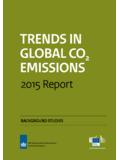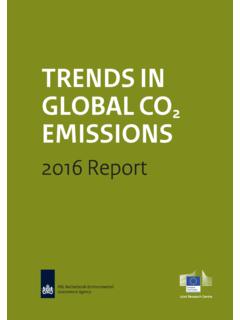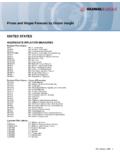Transcription of Supply Chain Management 4.0: Logis8cs within the bulk ...
1 Supply Chain Management : Logis8cs within the bulk cement industry Markus Lanz The 4 Stages of Industrial Evolu8on 4. Industrial revolu1on Based on cyber-physical- systems 3. Industrial revolu1on Through the use of electronics and IT further progression in autonomous produc8on 2. Industrial revolu1on Introducing mass produc8on lines powered by electric energy 1. Industrial revolu1on Introducing mechanical produc8on machines powered by water and steam End of the 18th century. Beginning of the 70th Industry Industry Industry Industry Level of complexity Today Manufacturing-Mega Trends Megatrends have considerable impact and drive structural changes in nearly all manufacturing sectors Changing demographics (growing world population, aging societies, increasing urbanization) Globalization & future markets (ongoing globalization, BRIC, beyond BRIC) Scarcity of resources (energy, water, other commodities) The challenge of climate change (increasing CO2, global warming, ecosystem at risk) Dynamic technology & innovation (technology diffusion, power of innovation, the age of life science, ubiquitous connectivity)
2 Global knowledge society (know-how base, gender gap, war for talent, multiplication of data and information) Sharing global responsibility (shift to global cooperation, growing power of NGO s, increasing philanthropy Smart Supply Chain Current State Mega Trends are driving the future face of Manufacturing Industry through rapid transforma1ons Capacity and Efficiency Disparate Plant Systems Make to Stock Supply Chain Capability and Flexibility Convergence of OT and IT Make to Individual Supply Circle Future State Historical Data Monitoring Real Time Dashboards 1 2 3 4 5 Factory of the Future Summary Objec1ve: Sustainable manufacturing ICT-enabled intelligent manufacturing High performance manufacturing Higher Automa8on A Transforma1on Framework leveraging OT and IT convergence Industrial Ethernet Mobile Applica8ons Automa8on Big M Data Analy8cs Digital Modeling and Simula8on Vision Framework Desired Stage Factory of the Future Defini8on & Vision Connected shop floor to Top Floor Systems (Business Systems 2 Way Integra1on) Ver1cally and Horizontally Integrated systems, instruments & informa1on Support the internal customer (paradigm shi\ with demonstrable and sustainable benefits))
3 Real-1me monitoring of machines, inventories and manual processes Full shop floor visibility/transparency (all plants and processes) RFID/Barcode s/QR-Codes etc. Smart Supply Chain Network Factory of the Future is paradigm shi\s from disconnected shop floor to connected manufacturing facili1es by automa1ng the flow of informa1on through ver1cal integra1on Shop Floor to the Top Floor and horizontal integra1on across the plant site, loca1ons What do we mean by Smart Supply Chain , and do we all mean the same thing? v Visibility of: v Product status v Real 8me demand and demand plans v Supply plans v Inventory levels by loca8on v Orders v And visibility of assets : v Vehicles, condi8on and capacity v Produc8on & Packaging equipment v Loading- & Unloading system v People and capabili8es If you can t measure it, you can t manage it!
4 How can it be so very difficult when we have the ability to use all these assets: Sta8c Supply Chain Func8onal Excellence Horizontal Process Integra8on External Collabora8on & Integra8on Smart Supply Chain Instrumented Interconnected Intelligent Integrated Transac8ons (ERP to ERP) Balancing risk and performance Effec8vely driving profitable growth Managing complexity Networked Planning, Execu8on & Decision Analysis Op8mized Flows Flexibility & stability Future CSCO Automated Transac8ons (Sensors & Actuators) Our Point of View on the Progression of Supply Chain Management to a Smarter Future Smarter Supply Chain The Supply Chain of the Future must be will be Instrumented, Interconnected & Intelligent Instrumented Interconnected Intelligent Automated Transac8ons & Smart Devices Op8mized Flows Networked Planning, Execu8on & Decision Analysis Use of sensors, actuators, RFID, & smart devices to automate transac,ons.
5 Inventory loca8on, shelf-level replenishment detec8on, transporta8on loca8ons & boalenecks Supports real-,me data collec,on & transparency from POS to manufacturing to raw material Sense-and-respond demand/ Supply signals allow predict and act Mul8-Tier system integra,on across the network. Standardized data and processes. Collabora,ve decision making through decision support and business intelligence star8ng with the customer Networked risk Management programs for integrated financial controls with opera8onal performance monitored and measured Simula,on models to evaluate trade-offs of cost, 8me, quality, service and carbon and other criteria Probability-based risk assessment & predic,ve analysis Networked planning/execu8on with op.
6 Mized forecasts & decision support Case Study cement Producer Key Challenges in cement Supply Chain v An end-to-end solu8on that addresses all aspects of the cement Supply Chain Management v Automated Order Management v Real 8me stock measurement v Rou8ng v Complete monitoring of the processes -- from loading of cement into the truck to delivery at customer site and return of the truck to the plant v The OrbitLog VMI-solu1on provides real 8me stock & distribu8on informa8on and integrates it within the ERP solu8on v The Service oriented LOGis8c System SoLOGS for automated self service loading v No reflec8on of the real inventory situa8on v Providing right informa8on to the client about every dispatch v Fleet Underu8liza8on v High Distribu8on Cost due frequent order changes or cancela8ons v Wai8ng 8me to unload trucks due unavailable silos v Manual order entry Solu1on Benefits v Reduced Inventory Cost v Reduced Delivery Cycle Time v Elimina8on of truck wai8ng 8mes v Improved Plant Produc8on Planning v Op8mizing rou8ng and transporta8on 8mes v Reduced administra8on v Cost reduc8on by approx.
7 20% Solu8on Tanks Webportal Customer SAP Automated consignment calcula1on Webportal Real-1me Inventory Forecast & Deliverystatus POD Terminals Barges Truck Railcar Supplier Customer SoLOGS Service oriented Logis8cs System 3e_Automate (English).mp4 Case Study Oil Producer Key Challenges in Oil/Gas Supply Chain v Integra8on between scheduling centers, terminals, trucks and customers assured robust planning and collabora8on v Automated Order Management v Real 8me stock measurement v Rou8ng v The OrbitLog VMI-solu1on provides real 8me stock & distribu8on informa8on and integrates it within the ERP solu8on v No reflec8on of the real inventory situa8on at petrol sta8ons v Unstructured order 8ming v Order volumes causing tankers to go out half full v Peaks & troughs during the weak due consumer demand and price changes Solu1on Benefits v Petrol sta8on Manager know when delivery will arrive v Elimina8on of truck wai8ng 8mes v Op8mizing rou8ng and transporta8on 8mes v Schedulers can maximize the deliveries in a shij v
8 Reduced administra8on Solu8on Tanks Automated consignment calculation Webportal Real-time Inventory Forecast & Delivery status POD Terminal Supplier Customer Fleet Op1mizing & Scheduling system POD Timestamp 3PL/4PL The vision: Real 8me collabora8ve planning & forecas8ng Collabora8ve network (customer / supplier / carrier) Demand Cloud Real-8me: orders + forecast + inventory + consump8on + loading + movements Order automa1on Customer order portal Proof of delivery Excep1on handling Company border Firewall Always external connec1ons internal RALOG Supply Chain Engagement Methodology v Product/Customer Porlolio analysis v Sales & Opera8ons Planning v Metrics Defini8on v Order To Cash Cycle Time v Return on Assets v Forecast Accuracy v Total Supply Chain Cost as % of Revenue v High Level Road Map v To-Be Process Design v Timeline v Resource/Staffing v Cost/Benefit v Iden8fica8on of possible solu8ons v Quick wins v Exis8ng Process standardiza8on and roll out.
9 If needed v Implementa8on v SCM Strategy v Organiza8onal change v Solu8ons v Project Management v Change Management v Training v Understand As-Is process & capture current performance. v Qualita8ve Analysis: Pain points and Issues iden8fica8on. v Quan8ta8ve Data Analysis: ( Product ABC based on revenue/gross margin/inventory) v Process and Performance Analysis v Process and Performance Gap Analysis v Iden8fy opportunity areas and Quick wins v Value Iden8fica8on and es8ma8on Discover Conduct As-Is Analyzes Deep Dive Defini,on To-Be Situa,on Deployment Defini,on To-Be Situa,on Markus Lanz Managing Partner/Senior Consultant RALOG Engineering AG Aarburgerstrasse 21 CH-4800 Switzerland Phone: +41 76 395 45 21 Mail to: Web: Thank you




